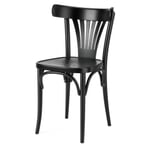TON coffee house chair No. 56

TON coffee house chair No. 56
- Classic: designed in 1885, unchanged since then
- Serviceable: proven in countless coffee houses
- Triad: light, almost indestructible and comfortable
General Information
Coffee house chair No. 56 is manufactured in a factory founded by the sons and successors of Thonet in 1861 in the Moravian city of Bystritz am Hostein, today Bystrice pod Hostýnem in the Czech Republic. Despite the turns of fortune it is still known today as TON (továrny na ohýbaný nábytek – "Factory for Bentwood Furniture").Bystritz is thereby the oldest and most revered location in the world where furniture is still manufactured by manually bending wood.
Bent and embossed.
We offer the bentwood chairs with a black lacquered finish or in a stained und clear varnished brown. The chairs are embossed with the patterns from the old templates, a technique, which like the manufacture of the bentwood furniture itself, is an industrial procedure.
"Consumer furniture".
The selection of bentwood furniture TON manufactures is increasing annually, which one can see at the relevant furniture fairs every year. In addition the various chairs are still produced based on the earlier designs from the founding of the firm, which are considered classical chairs today. At the time those models which later became famous were mass produced (in the 19th century they were called "consumer furniture "). Which is how they became the coffee house chairs for an entire epoch. Chairs like those that became known as Model No. 14, with its curved backrest made of two bentwood arches, the coffee house chair par excellence, or the armchair No. 24, with its "palmette" executed backrest embodied designs which reflected the Zeitgeist. They owe their wide distribution to their minimal weight, their comfort and the fact because of their industrial manufacture, they were affordable, qualities which still distinguish them today.
Bent and embossed
We offer the bentwood chairs either black lacquered or braun stained and clear lacquered. Their seats are embossed with patterns based on old patterns - a technique that, like the manufacture of bentwood furniture itself, requires machine and industrial production.
"Consumer furniture"
The range of bentwood furniture that TON manufactures is wide - and year after year they are represented at the usual furniture fairs with novelties. In addition, the company produces a number of chairs that date back to the early designs of the Wilhelminian period and are considered classics today. First and foremost, however, even the later famous models were mass-produced items in their day (in the 19th century they spoke of "consumer furniture"). This was the only reason why they could become the typical coffee house chairs of an entire era. Chairs such as model No. 14 below with its curved backrest made of two bentwood arches - the coffee house chair par excellence - or the armrest chair No. 24 with its "palmette" backrest certainly met the taste of the time in terms of design. However, they owe their widespread popularity to their light weight, their indestructibility, their seating comfort and the fact that they were inexpensive as a result of industrial mass production - characteristics that distinguish them even today, above and beyond all design issues.
How the wood was bent
Revolutions in furniture making are a rather rare thing. The perfection of the bentwood chair by Michael Thonet (1796-1871) was such a revolutionary act - in three respects. From a technical point of view, the revolution had been in the offing since about 1830. Michael Thonet experimented with methods of making wood bendable under the effect of steam and glue water. He improved them step by step; in 1852, after several attempts, he finally obtained a patent that protected his method of "giving wood any bend and shape in various directions by cutting it up and gluing it back together." "Any bend" - this phrase hints at the second revolution. With the help of bentwood technology, it was also possible to break new ground in design; simple semicircular arches as backrests, round-shaped yet solid-wood combinations of chair backs and backrests, or even curved chair leg reinforcements were not only technical innovations, but also innovations in design. Thirdly, bentwood furniture marked an economic revolution. They were not only suitable for production on an industrial scale, they virtually required it. And so, even during Michael Thonet's lifetime, the idea of bentwood furniture led to an industry of its own. His sons and successors mass-produced bentwood chairs and founded numerous manufacturing plants, primarily in the Eastern European region, which at the time belonged to imperial and royal Austria. Austria, where labor was cheap and the supply of beech wood was almost inexhaustible. One of these factories was established in 1861 in the Moravian town of Bystritz am Hostein, now Bystrice pod Hostýnem in the Czech Republic. It operates after a checkered history as an independent joint stock company under the name TON (továrny na ohýbaný nábytek, in German "factory for bentwood furniture") still today: Bystritz is the oldest place in the world where furniture is made by bending wood by hand.
Product Information
Article Number 68909
- Classic: designed in 1885, unchanged since then
- Serviceable: proven in countless coffee houses
- Triad: light, almost indestructible and comfortable
Lacquered beechwood. Galvanized steel connecting elements. Seat made of embossed plywood. Height 80.5 cm, width 45 cm, depth 48.5 cm. Seat height 46 cm, seating surface 39.5 x 40.5 cm. Weight 3.6 kg.
Have a question?
If you have a question concerning this product you are welcome to contact us. For this your E-Mail program will open.
Contact Us
For advice, spare parts or special requests - our customer service will take care of your questions and concerns, personally and competently.
You can reach us from Monday to Friday at +49 2309 939095 or anytime at info@manufactum.com
Gift Certificates
It is good for everything: With our PDF gift certificates you can choose from the entire Manufactum selection. Pick a motif which you can send by email or print out and present personally, immediately after submitting your order.
Order now


